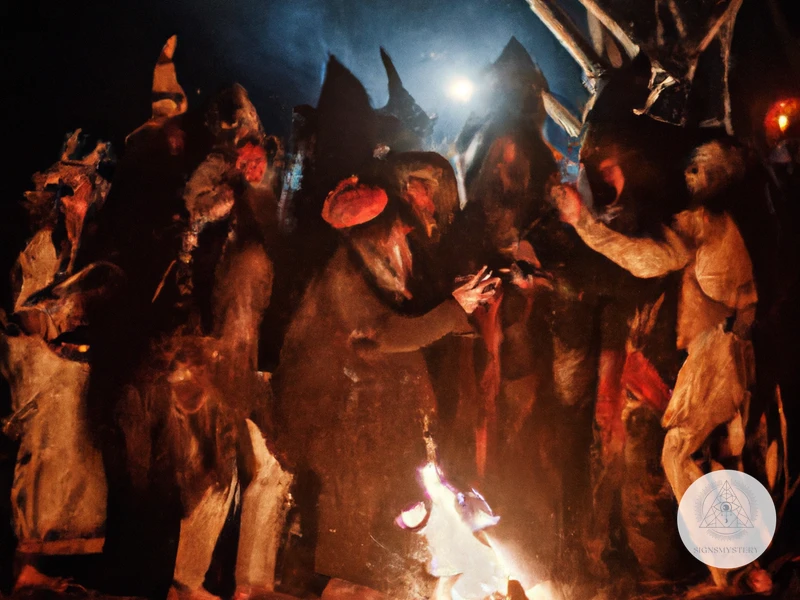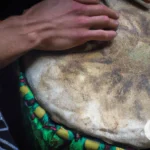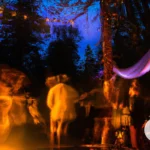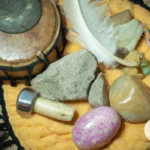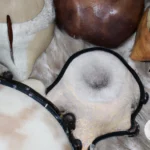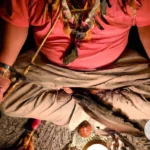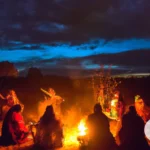Shamanic ceremonies have been practiced by indigenous cultures for centuries, serving as a way to connect with the spiritual world. One of the key elements of these ceremonies is the recognition and honor of the four cardinal directions: East, South, West, and North. Each direction holds its own significance and holds the key to unlocking different aspects of spiritual knowledge and guidance. By understanding the importance of these directions, individuals can deepen their connection to themselves and the world around them. In this article, we will explore the significance of each direction and the tools used to connect with them, as well as how to incorporate these practices into your own spiritual journey.
The Significance of the Four Cardinal Directions in Shamanism
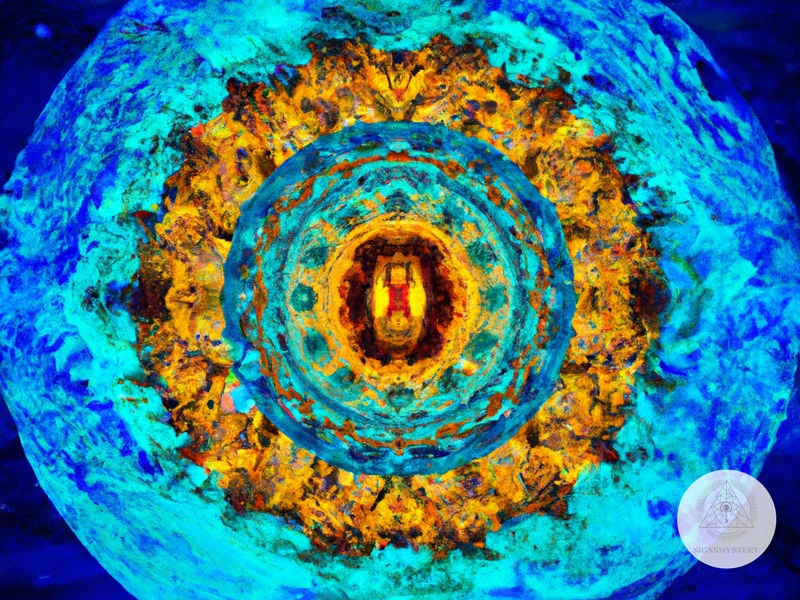
In shamanism, the Four Cardinal Directions hold great significance and are often incorporated into ceremonial practices. Each direction represents a different energy and element, and can be called upon for specific purposes during a ceremony. The Eastern direction is associated with new beginnings and is often where the ceremony will start. The South represents passion and transformation, while the West symbolizes introspection and closure. Lastly, the North represents wisdom and guidance. These directions can be honored and called upon using a variety of tools such as drumming, rattles, feathers, crystals, and medicine wheels. Incorporating the Four Cardinal Directions into shamanic ceremonies can enhance the energy and intention of the practice and offer a deeper connection to the universe.
The East
In shamanism, the East is associated with new beginnings and represents spring and childhood. It is also considered the place of the rising sun and the element of air. In shamanic practice, the East is often honored as a place of pure potential, where one can set intentions for new beginnings and fresh starts.
To honor the East in your practice, you can create an altar facing the East, and adorn it with symbols of the East such as feathers or bird imagery. You can also use a feather or fan to represent the element of air during a ceremony. Another tool commonly used to honor the East is the drum, which represents the heartbeat of Mother Earth and the energy of new beginnings and creation.
During a shamanic ceremony, the East can be invoked through singing or chanting songs that embody the spirit of new beginnings and the energy of spring. Some shamanic practitioners may also use ritual hallucinogens to connect with the spirit of the East, while others may use fire and smoke to purify the space and prepare for the newness of the East.
The East is a powerful direction in shamanic practice, representing the infinite possibility of new beginnings and the energy of creation. Whether through drumming, chanting, or the use of ritual tools, the energy of the East can be harnessed to support positive change and growth in one’s life.
The South
represents the element of fire and embodies energy, passion, and creativity. It also signifies youth, innocence, and trust. During a shamanic ceremony, facing South can help us tap into our inner child and connect with our passions and creativity. This direction can help us ignite the fire within us and find the strength and courage to pursue our dreams.
In traditional shamanic practices, the South is often associated with the archetype of the Serpent, which represents transformation and healing. The Serpent sheds its skin to reveal a new self, just as we have the potential to shed old habits and beliefs to reveal our true selves. The South is also associated with the season of summer, which symbolizes growth, expansion, and abundance.
Shamans may use different tools to connect with the South during a ceremony, such as drums or rattles to mimic the sound of fire, or feathers representing the element of air to fan the flames. They may also use crystals or stones such as carnelian, which is believed to enhance creativity and passion.
In a personal shamanic practice, you can honor and connect with the South by incorporating fire into your practice. This can be as simple as lighting a candle or working with a fire element such as charcoals or incense. You can also take inspiration from traditional indigenous cultures that use fire in their shamanic rituals, such as the use of sweat lodges, which involve heating stones and pouring water on them to create steam for purification and relaxation.
When working with the South, it can be helpful to set intentions related to creativity, passion, or transformation. Take some time to reflect on what you want to ignite within yourself and offer gratitude for the blessings in your life. By honoring the South, we can tap into our inner fire and find the strength to pursue our passions and live a fulfilling life.
The West
The West: The direction of the West is associated with the setting sun, autumn season, water, and introspection. It is the place of endings, letting go, and releasing what no longer serves us. When Shamans call upon the West, they are asking for the guidance and strength to let go of the past, and welcome changes and transitions in their lives.
In many Shamanic traditions, the West is connected with the element of water, which symbolizes emotional and spiritual purification. As the sun sets in the West, it signifies a time of reflection and inner journeying. During Shamanic ceremonies, the West is often honored through water rituals, where participants are encouraged to immerse themselves in water, visualize a releasing of emotional baggage, and open themselves to the flow of new positive energies.
To get in touch with the West, shamans use various tools such as a chalice filled with water, to represent the element of water. The water can be used in purification rituals to cleanse both the physical and emotional body. Shamans also use stones like the black obsidian and herbs like sage to help them connect with the energy of the West.
When calling on the West in shamanic practices, one can also use affirmations or mantras to help manifest the energy of the West. According to Shamanic practices, the West is associated with the journey toward enlightenment, and connecting with this direction can bring clarity and a deeper understanding of the world around us.
The West represents the introspective aspects of our spiritual journey and helps us find the courage to face our fears by acknowledging our vulnerabilities. To learn more about Shamanic practices, check out other articles on exploring ritual hallucinogens in indigenous cultures and the power of trance in shamanic rituals.
The North
In shamanism, the North is associated with the element of Earth, winter, and old age. It symbolizes wisdom, strength, and the ability to endure hardships. Honoring the North in a shamanic ceremony can help us connect with our inner wisdom and help us to stay grounded in difficult times.
The animals associated with the North are:
- The buffalo, representing abundance and gratitude.
- The white buffalo calf woman, who brings wisdom and sacredness to our lives.
- The eagle, who represents the ability to soar above our problems and see the bigger picture.
- The mole, who helps us to connect with the Earth and our grounding energy.
The crystals associated with the North are:
| Crystal | Properties |
|---|---|
| Quartz | Harmony, clarity, and healing. |
| Amethyst | Spiritual insight and awareness. |
| Obsidian | Protection and grounding during spiritual work. |
| Hematite | Grounding and strength during difficult times. |
When honoring the North in a shamanic ceremony, you may want to use some of these items in your ritual. You can also meditate on the qualities associated with the North and ask for guidance and wisdom during your journey. The North is an important direction in shamanic ceremonies and can help us to stay connected with our inner strength and wisdom.
Tools Used to Connect with the Four Directions
The tools used to connect with the four directions in shamanic ceremonies are diverse and powerful. Drums create a rhythmic beat that helps the shaman and participants enter a trance state, while rattles provide a sharp and precise sound that helps to clear negative energy. Feathers are utilized to smudge and cleanse the energy of the space and participants, while crystals and stones are employed for their unique healing and energetic properties. Prayer ties and medicine wheels serve as powerful symbols of intention and connection. Each tool holds profound significance and can be used to enhance the shamanic experience.
Drums
Drums are one of the most familiar tools utilized by shamans in ceremonies to connect with the four directions. They are considered sacred because of their ability to produce a consistent beat that can facilitate an altered state of consciousness. Drums are played in a rhythmic manner that mimics the beating of the human heart and can create a trance-like state for the shaman and participants.
Shamans use several different types of drums during their ceremonies, each with its own unique tone. Some of the most commonly used types of drums include:
| Type of Drum | Description |
|---|---|
| Frame Drum | A large drum with a shallow depth and a wide surface area. This drum is usually held in one hand and played with the other using a soft mallet or beater. |
| Bass Drum | A large drum with a deep sound that is played on the ground using a soft or hard beater. |
| Hand Drum | A small, handheld drum that can be played with the fingers or a beater. This drum is perfect for the shaman on the move. |
| Frame Drum with Beater | A frame drum played with a soft beater, producing a mellower sound than that produced by drumming with the hands. |
When playing the drum, shamans believe that they are sending out a message to the spirits of the four directions and the universe. The beat of the drum represents the heart of the shaman and their connection to the spirit world. If you are interested in incorporating drums into your own practice, you can purchase one from a reputable source or make your own using a frame, hide, and drumhead.
In addition to the drum, other tools such as rattles, feathers, crystals and stones, prayer ties, and medicine wheels can help shaman to connect with the four directions during their ceremonies. To learn more about these tools and how they are used in shamanic ceremonies, check out the shamanic altar ceremonies section of this article.
Rattles
are another tool used in shamanic ceremonies to connect with the four directions. Rattles are typically made of natural materials such as gourds, seashells, or animal hide and are filled with materials such as pebbles or seeds. They are used to create a rhythmic sound that can help to induce a trance-like state and facilitate communication with the spirit world.
During a shamanic ceremony, the shaman may use the rattle to guide participants through different stages of the ritual or to help connect with a specific spirit or direction. The shaman may also pass rattles around to the participants, allowing them to use the tool to connect with the energy of the four directions and to contribute to the overall sound of the ceremony.
Rattles can also be used in individual shamanic practice. To use a rattle, simply hold it in your dominant hand and shake it rapidly to produce a consistent rhythmic sound. You can use your rattle as a way to set an intention and focus your energy before a ceremony or meditation. It can also be used to help clear energy and release emotional tension during a healing session.
In addition to using a rattle, some shamans use other sound tools such as bells or singing bowls in their ceremonies. These tools can also be effective in helping to create a meditative state and connect with the energy of the four directions.
Using a rattle in shamanic practice can be an effective way to connect with the four directions and facilitate communication with the spirit world. When used in combination with other tools and techniques such as chanting, drumming, and breathwork, rattles can help to create a powerful and transformative shamanic experience.
Feathers
Feathers have played an essential role in Native American ceremonies for centuries. Shamans and spiritual leaders use feathers to connect with the four directions, which represent different aspects of nature and life. Feathers also symbolize the ability to fly high above and gain a higher perspective, which is crucial in shamanic practices.
There are different types of feathers used in shamanic ceremonies, each with its unique meaning and significance. For example, eagle feathers are considered the most sacred and represent courage, strength, and wisdom. The use of eagle feathers is highly regulated, and only Native Americans who are registered with the federal government can possess them legally.
Other feathers commonly used in shamanic ceremonies include owl feathers, which symbolize mystery and magic, and hawk feathers, which represent vision and clear-sightedness. Shamans also use turkey feathers, which stand for abundance and generosity, and peacock feathers, which are associated with beauty and transformation.
During shamanic ceremonies, feathers are used for smudging and energy cleansing. Shamans often wave feathers over a person’s body or use them to fan smoke from burning herbs, such as sage or sweetgrass, during purification rituals. The feathers are believed to help move energy and negative emotions from a person’s energy field.
Aside from cleansing, feathers are also used to call in specific energies or spirits from the four directions. Shamans might hold a feather in each direction while reciting prayers or chanting to connect with the spirits of nature. In some ceremonies, participants hold a feather during a specific part of the ceremony, as it helps them focus their intentions.
It is crucial to use feathers in a respectful and sacred manner during shamanic ceremonies as they are considered powerful tools of spiritual connection. Inappropriate handling, such as using them as fashion accessories or non-spiritual purposes, is thought to bring about negative energy.
Feathers are significant tools in shamanic ceremonies for connecting with the spirit world and the four cardinal directions. They are used for smudging, calling in energies, and moving negative energies from a person’s aura. By understanding the unique qualities of each feather, you can enhance your spiritual practice and deepen your connection with nature, the spirits, and oneself.
Crystals and Stones
Crystals and stones have been used in various spiritual practices for centuries, including Shamanic ceremonies. They are believed to hold unique energies and can be used to connect with the four cardinal directions in Shamanism.
There are different types of crystals and stones that can be used for this purpose. Here are some examples:
| Crystal/Stone | Direction | Properties/Energies |
|---|---|---|
| Amethyst | North | Calming, spiritual awareness, clarity of thought |
| Citrine | South | Abundance, creativity, joy, confidence |
| Red jasper | East | Warmth, grounding, stability, protection |
| Turquoise | West | Healing, emotional balance, communication, spiritual attunement |
During a Shamanic ceremony, crystals and stones can be laid out in a pattern that represents the four directions, with each crystal or stone placed in the corresponding direction. This can help to enhance the connection with each direction and its unique energy.
Alternatively, a Shamanic practitioner may choose to hold a crystal or stone during the ceremony or use it as a focal point for meditation. The crystal or stone can also be placed on an altar or special cloth that represents the four directions.
It’s important to note that choosing the right crystal or stone for a Shamanic ceremony is a very personal process. Each individual may have their own intuitive sense for which crystal or stone resonates with them for a particular purpose. It’s also important to properly cleanse and charge the crystal or stone before use, which can be done through various methods such as /pre-ritual-purification/ or placing the crystal or stone in sunlight or moonlight.
Crystals and stones can be a powerful tool for connecting with the four cardinal directions in Shamanism and enhancing the energy and intention of a Shamanic ceremony. For those interested in diving deeper into the use of crystals and stones in Shamanic practice, there are many resources available, such as workshops, books, and online resources. Another tool commonly used in Shamanic ceremonies is /music-chanting-shamanic-ceremonies/ and /fire-and-smoke-in-shamanic-rituals/, which can also be very effective for creating a sacred and transformative space.
Prayer Ties
Prayer ties are an important tool used in shamanic ceremonies to show gratitude, make offerings, and send prayers to the spirits. They are small bundles of cloth filled with sacred items and tied together with a string. The colors of the ties are significant and represent the four cardinal directions. Often, prayer ties are tied to trees or other objects as a physical representation of the offering made.
What do prayer ties symbolize?
Each prayer tie is usually filled with offerings such as tobacco, sage, cedar, or other sacred herbs. These offerings are considered sacred and provide a connection to the spirits. Prayer ties symbolize gratitude and respect for the spirits, as well as a desire for their guidance and protection. They can also symbolize the connection between all things.
How to make prayer ties
To make prayer ties, take small squares of cloth and fill them with sacred materials. Then, tie them together with a string, leaving a long end to tie the ties to a tree or object. The colors of the cloth should represent the four cardinal directions – yellow for the East, red for the South, black for the West, and white for the North. Traditionally, prayers or intentions are spoken while making the ties.
Using prayer ties in ceremony
During shamanic ceremonies, prayer ties are often used as offerings or as a way to send prayers to the spirits. They may be tied to a tree or other object, or they may be placed in a sacred fire to release the prayers and offerings to the spirits. Some shamanic practitioners also use prayer ties for divination, interpreting the way in which the ties fall after being thrown.
Prayer ties are a powerful tool for connecting with the spirits and honoring the four cardinal directions. They are a beautiful and meaningful way to show gratitude and respect in shamanic ceremonies.
If you are interested in learning more about other tools used in shamanic ceremonies, check out our article on Divination Tools in Shamanic
Ceremonies.Medicine Wheels
are another tool used in shamanic ceremonies to honor and connect with the four cardinal directions. These sacred circles are constructed using stones, crystals, and other natural materials and are often used to represent the cycle of life, death, and rebirth.
In Native American culture, medicine wheels can have different meanings depending on the tribe and the individual. Some tribes view them as a way to connect with the Great Spirit or the universe, while others use them as a symbol of community and harmony.
Medicine wheels usually consist of a central stone or crystal, with additional stones placed in a particular pattern around it. These stones can be arranged in a number of ways depending on the purpose of the ceremony or the beliefs of the tribe.
When working with a medicine wheel, individuals may walk around it in a clockwise direction, stopping at each of the four cardinal directions to offer thanks and gratitude. They may also use it as a focal point for meditation or reflection, allowing the energy of the circle to guide their thoughts and intentions.
Creating a medicine wheel can be a powerful and meditative process in and of itself. Individuals may choose to collect their own stones and crystals, infusing them with their own intention and energy before arranging them in the circle. Others may prefer to work with a pre-made medicine wheel, incorporating their own items and beliefs into the existing structure.
In either case, it is important to approach the process with reverence and respect, recognizing the sacred nature of the circle and the energy it holds. Whether used as a visual aid or simply as a representation of the four directions, medicine wheels can be a powerful tool for spiritual connection and growth in shamanic practice.
How to Honor and Connect with the Four Directions in Your Own Practice
One powerful way to honor and connect with the Four Directions in your own shamanic practice is by creating an altar that represents each direction. You can use a table with four corners or a circular arrangement of objects that correspond to the elements and energies of each direction. For example, in the East direction, you can include a feather or a bird figurine to represent air and new beginnings, while in the South, you can place a piece of red cloth or a candle to represent fire and passion. In the West, you can add a seashell or a dish with water to represent emotions and intuition, and in the North, you can place a stone or a plant to represent earth and wisdom. While setting up the altar, you can speak aloud your intentions and gratitude for each direction and invite their energies to guide and protect you on your journey.
Creating an Altar
Creating an altar is a powerful way to connect with the four cardinal directions in shamanic practice. By creating an altar, you are creating a physical space that serves as a focal point for your intentions and prayers. Here are some steps to follow when creating your own altar:
Step 1: Choose a location for your altar. This can be a table or shelf in your home, or an outdoor location that feels sacred to you.
Step 2: Begin by placing an object that represents the east on the eastern side of your altar. This could be a feather, a candle, or an image of the sun.
Step 3: Move clockwise, placing an object that represents the south on the southern side of your altar. This could be a shell, a crystal, or an image of fire.
Step 4: Continue around the circle, placing an object that represents the west on the western side of your altar. This could be a bowl of water, a seashell, or an image of the setting sun.
Step 5: Finally, place an object that represents the north on the northern side of your altar. This could be a rock, a piece of fur, or an image of the northern lights.
Step 6: You can also add other objects to your altar that are meaningful to you. These might include photos of ancestors, symbols of the natural world, or items that represent your spiritual path.
Step 7: Once your altar is complete, take a moment to set an intention for your practice. This might be a prayer for healing, guidance, or protection. Light a candle or set out an offering as a symbol of your intention.
By creating an altar, you are opening a sacred space in your home or outdoor environment that can serve as a powerful reminder of the interconnectedness of all things. Take time to sit and meditate at your altar, offering prayers to the four directions and connecting with the energy of the natural world. With practice, you will develop a deep and meaningful connection to the four cardinal directions and the wisdom they hold.
Opening and Closing Ceremonies
Opening and closing ceremonies are an important part of any shamanic practice or ceremony. These ceremonies are performed to open and close a sacred space, to set the intention, and to honor the spirits of the four directions. Here are some tips to help you conduct effective opening and closing ceremonies:
| Tip | Description |
|---|---|
| 1. | Cleanse the space. Before starting the ceremony, it’s important to cleanse the space by smudging with sage, palo santo, or other sacred herbs. This is to purify the energy and create a safe and sacred space. |
| 2. | Call in the spirits of the four directions. Start by facing the East and calling in the spirit of the East, then turn to the South, West, and North, and call in the spirits of those directions. You may use a drum or rattle to help support your calling. |
| 3. | Set your intention. State your intention for the ceremony, what you hope to achieve or gain from it. This should be a heartfelt and authentic statement. |
| 4. | Offer gratitude. Thank the spirits of the four directions for their guidance and assistance. Express your appreciation for their presence and support. |
| 5. | Perform your ceremony. This may involve meditation, prayer, drumming, or other shamanic practices. |
| 6. | Close the ceremony. When you are finished, thank the spirits of the four directions again, and bid them farewell. Turn to each direction in the opposite order you called them. For example, if you started by facing East, then end by facing West. You may use a drum or rattle to support your farewell. |
By following these tips, you can create a sacred space and connect with the spirits of the four directions in a meaningful way. Remember that these ceremonies are meant to be genuine and come from the heart. Allow yourself to be open and vulnerable in your practice, and you may find that you develop a deep and lasting connection with the spirits of the four directions.
Setting Intentions and Offering Gratitude
Intention setting is a powerful practice that can help focus your energy and attention on achieving your goals. In shamanic ceremonies, setting intentions for each cardinal direction helps to create a clear and meaningful ceremony.
Before beginning your ceremony, take a moment to reflect on your intentions. What do you hope to gain from connecting with the four directions? Are there any specific challenges or obstacles you hope to overcome? Visualize your intentions as clearly as possible, and set them with intention and purpose.
Once you have set your intentions, it is important to offer gratitude to the four directions. Each direction represents a unique aspect of the natural world, and by offering gratitude, we acknowledge and honor their power and influence in our lives.
To offer gratitude, you may choose to speak aloud, offer a prayer or song, or simply bow your head in appreciation. Take the time to connect with each direction individually, expressing your gratitude and honoring the gifts they offer to your life.
As you move through your ceremony, keep your intentions and gratitude at the forefront of your mind. By focusing your energy and attention in this way, you can create a powerful and transformative experience for yourself and those around you.
Developing a Deep Connection over Time
Developing a deep connection with the four directions is a journey that requires patience, commitment, and respect. It is not something that can be achieved overnight, but rather it is a practice that takes time to develop. One way to deepen your connection with the four directions is by spending time in nature and observing the natural world around you.
Practice Gratitude: Expressing gratitude is an essential part of shamanic practice, especially when it comes to connecting with the four directions. Take a few moments each day to sit quietly and reflect on the blessings in your life. Whether it is your health, your family, or your home, take a moment to express your gratitude for these things. You can also offer thanks to the elements of nature that represent each direction, such as the rising sun in the East, the warmth of the South, the setting sun in the West, and the cold winds of the North.
Meditate: Meditation is a powerful tool for developing a deep connection with the four directions. Sit quietly in a comfortable position and visualize yourself standing at the center of a medicine wheel facing each direction in turn. Focus on your breath as you turn your attention to each direction, opening yourself up to the energy and wisdom of each element. Over time, this practice will help you to develop a clearer understanding of the unique qualities of each direction and how they can be incorporated into your daily life.
Use Symbols: Another way to deepen your connection with the four directions is by using symbols. You can create a sacred space in your home that is dedicated to the four directions, using items such as feathers, crystals, or stones to represent each element. You can also use these symbols during your shamanic practice, as a way of inviting the energy of each direction into your life.
Connect with Others: Developing a deep connection with the four directions is a personal journey, but it can also be helpful to connect with others who share your spiritual beliefs. Joining a shamanic community or attending a workshop or ceremony can help to deepen your understanding of the four directions and provide you with a support system to help you on your journey.
Remember, developing a deep connection with the four directions is a process that takes time, patience, and respect. By being open to the wisdom and energy of each direction, you can enhance your spiritual practice and deepen your relationship with the natural world.
Conclusion
In conclusion, the four cardinal directions hold immense significance in shamanic ceremonies. Each direction represents a different element, energy, and aspect of life. By honoring and connecting with these directions, we can tap into their power and use it for healing, growth, and transformation.
Through the use of tools such as drums, rattles, feathers, crystals, and prayer ties, we can deepen our connection to each direction. It is important to approach these tools with respect and reverence, understanding that they are powerful allies on our shamanic journey.
Creating an altar and holding opening and closing ceremonies can also help us to honor and connect with the four directions in our own practice. This can include setting intentions, offering gratitude, and developing a deep connection over time.
As we continue on our shamanic path, we can draw upon the wisdom and guidance of the four directions to navigate the challenges and opportunities that come our way. With an open heart and an open mind, we can access the transformative power of shamanism and emerge stronger, wiser, and more connected to the world around us.
Frequently Asked Questions
What is the significance of the four directions in shamanic ceremonies?
In shamanic ceremonies, the four cardinal directions represent different energies and aspects of life. By connecting with each direction, the shaman is able to access different realms and connect with spiritual beings.
What does the East represent in shamanism?
The East represents new beginnings, springtime, and the element of air. It is associated with the mind, vision, and clarity of thought.
What does the South represent in shamanism?
The South represents the summer season, the element of fire, and the emotional realm. It is associated with passion, creativity, and the hearth.
What does the West represent in shamanism?
The West represents the fall season, the element of water, and the realm of the unconscious. It is associated with emotions, dreams, and intuition.
What does the North represent in shamanism?
The North represents winter, the element of earth, and the realm of the body. It is associated with physical health, strength, and endurance.
What tools are used to connect with the four directions?
Tools used to connect with the four directions in shamanic ceremonies include drums, rattles, feathers, crystals and stones, prayer ties, and medicine wheels.
What is a medicine wheel?
A medicine wheel is a sacred circle that represents the cycle of life and the interconnection of all things. It is used for prayer, meditation, and healing.
How can I honor the four directions in my own practice?
You can honor the four directions in your own practice by creating an altar, performing opening and closing ceremonies, setting intentions, and offering gratitude. Developing a deep connection with each direction over time is also important.
What is the importance of setting intentions and offering gratitude?
Setting intentions and offering gratitude in shamanic ceremonies is important as it helps to focus your energy and intention towards a specific goal or outcome. Gratitude is also a powerful way to acknowledge the blessings in your life and attract positive energy.
Why is developing a deep connection over time important in shamanic practice?
Developing a deep connection with the four directions over time allows you to access deeper levels of spiritual wisdom and insight. This connection also helps to build trust and confidence in your own intuition and ability to connect with the spiritual realms.

